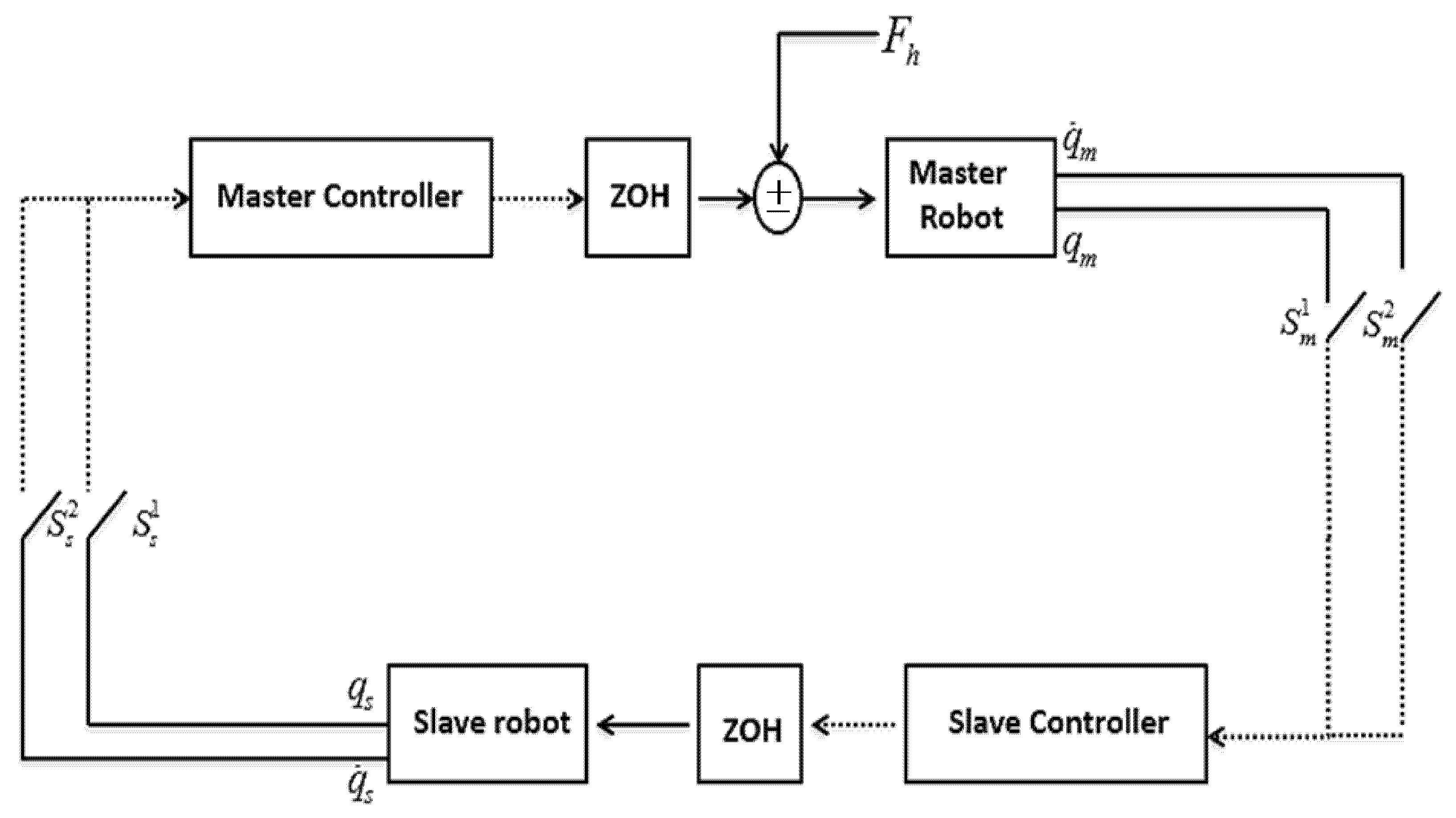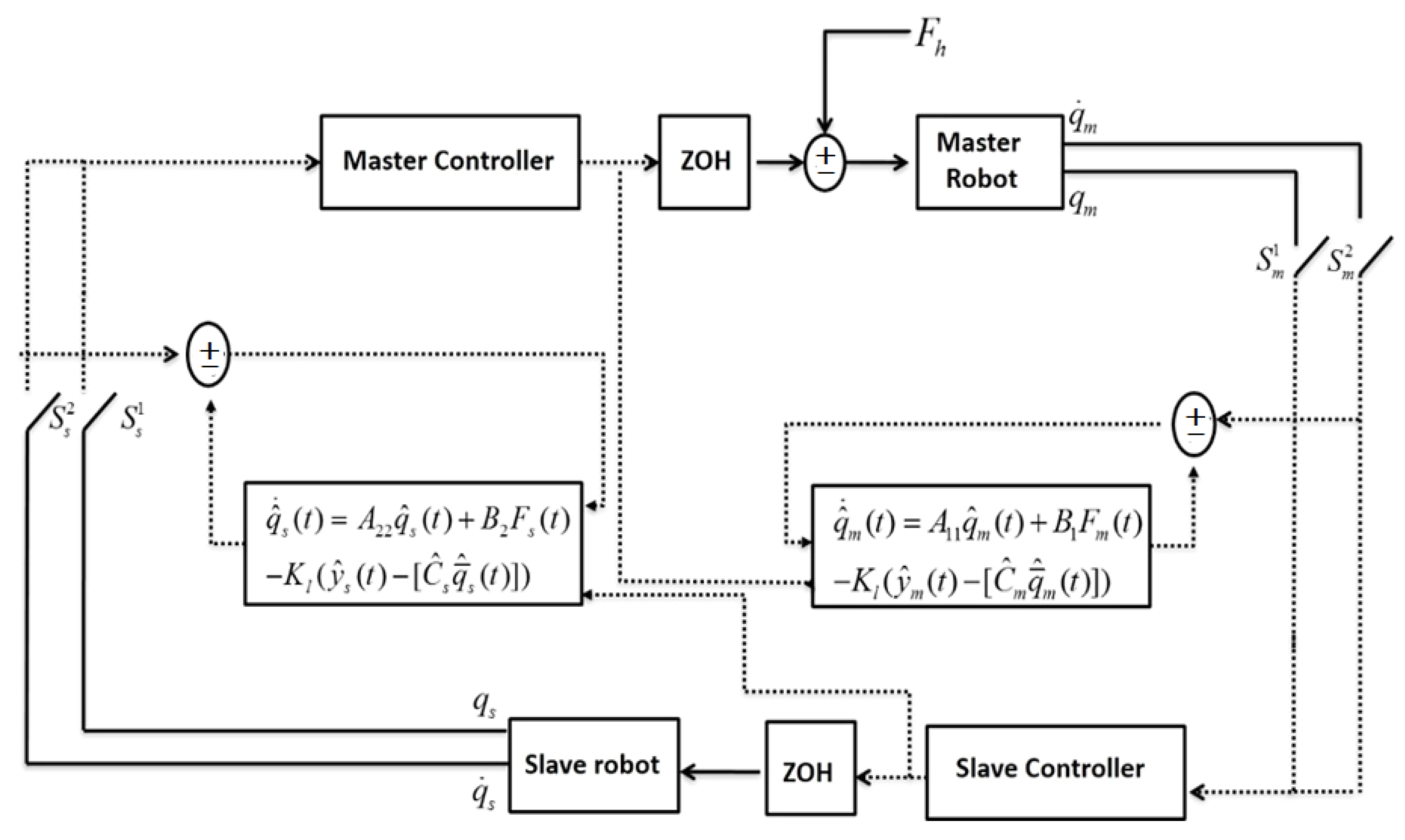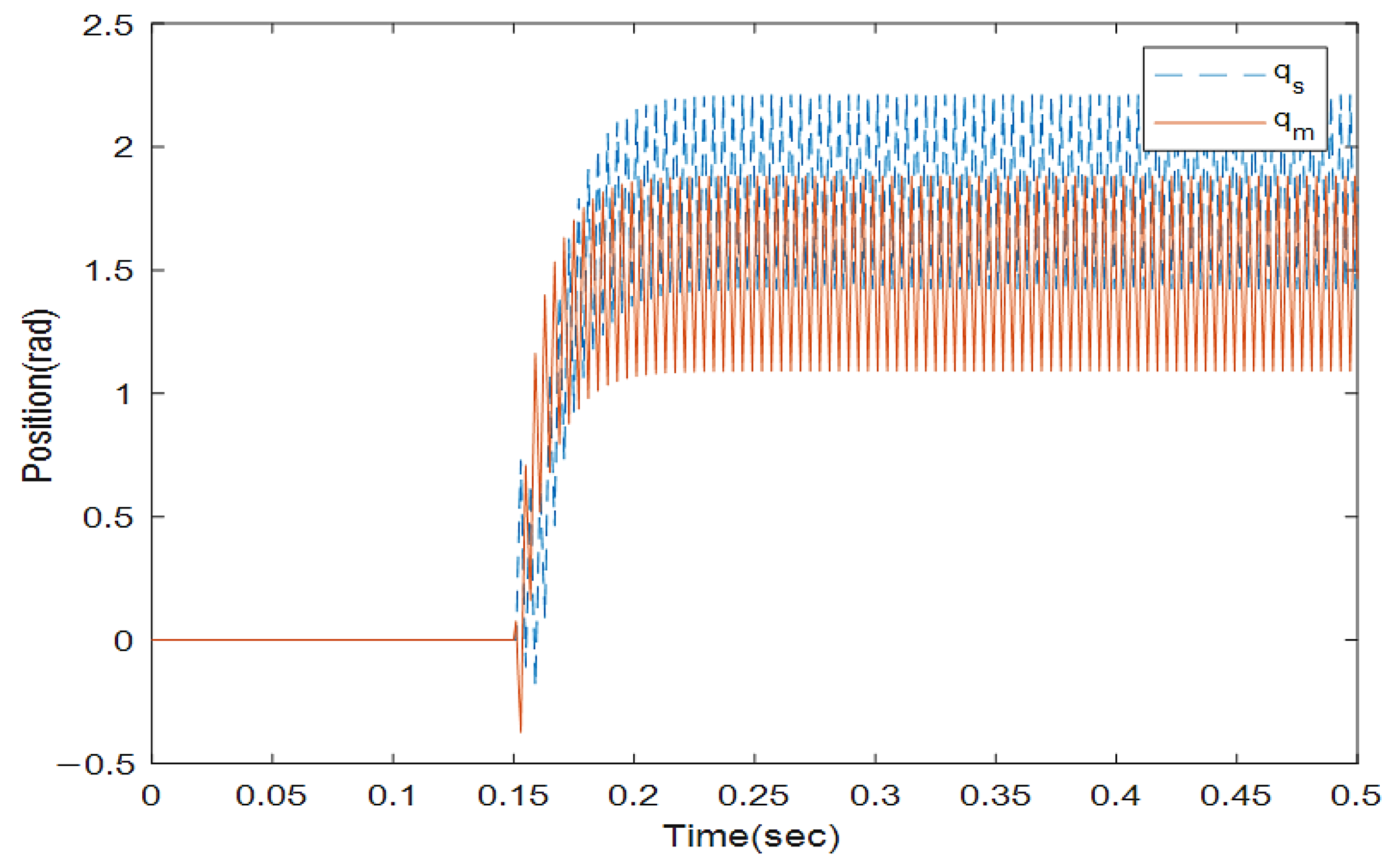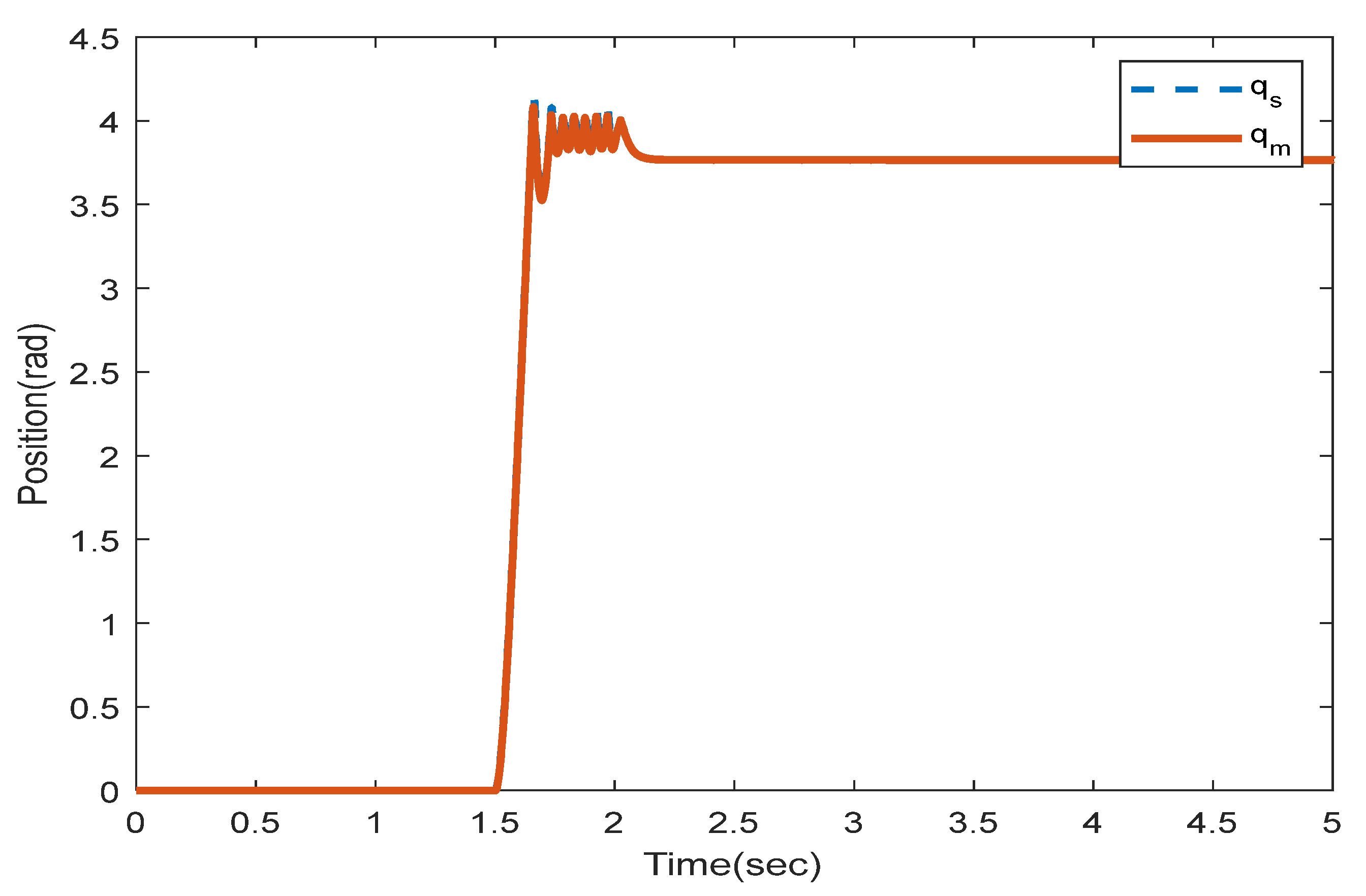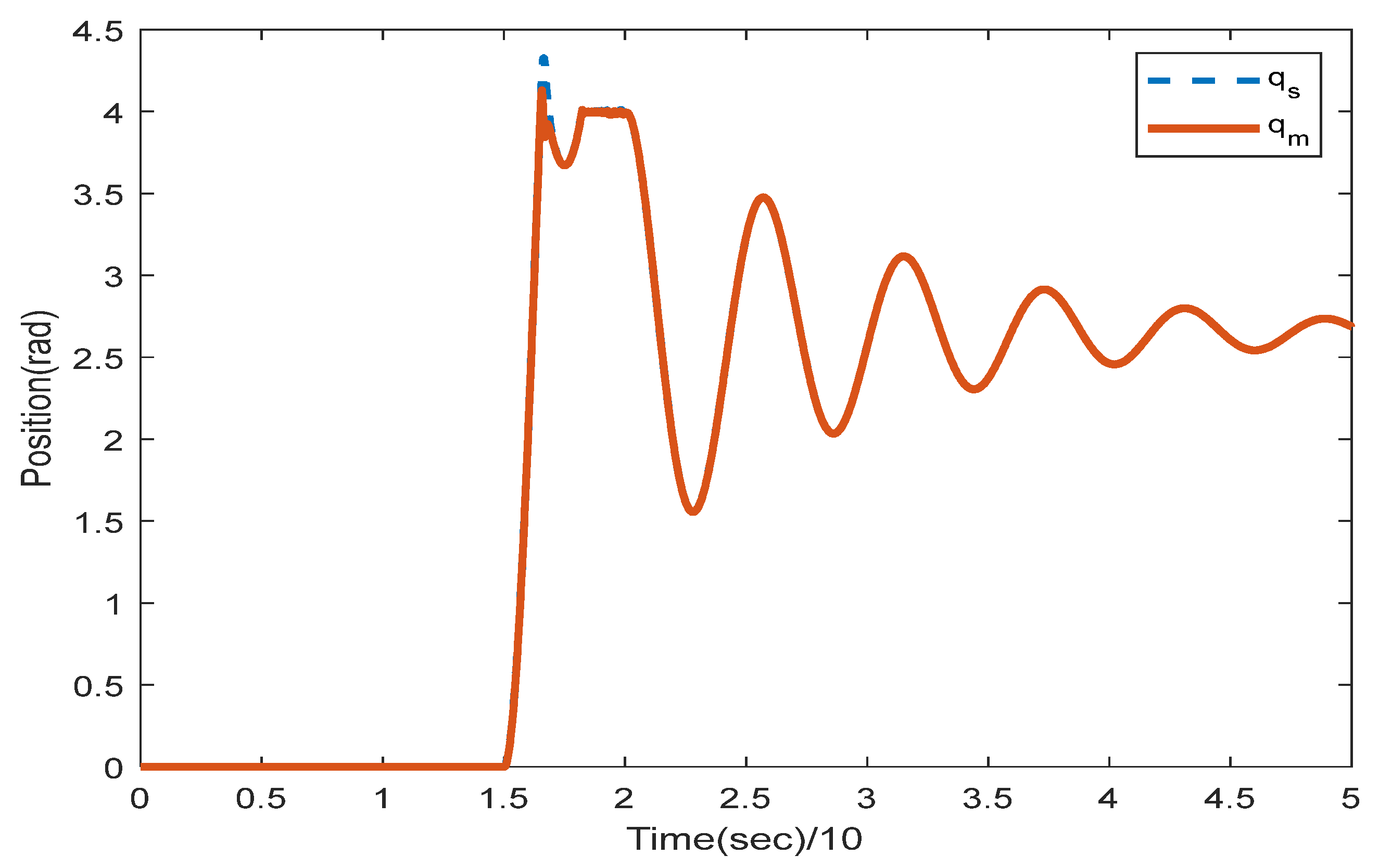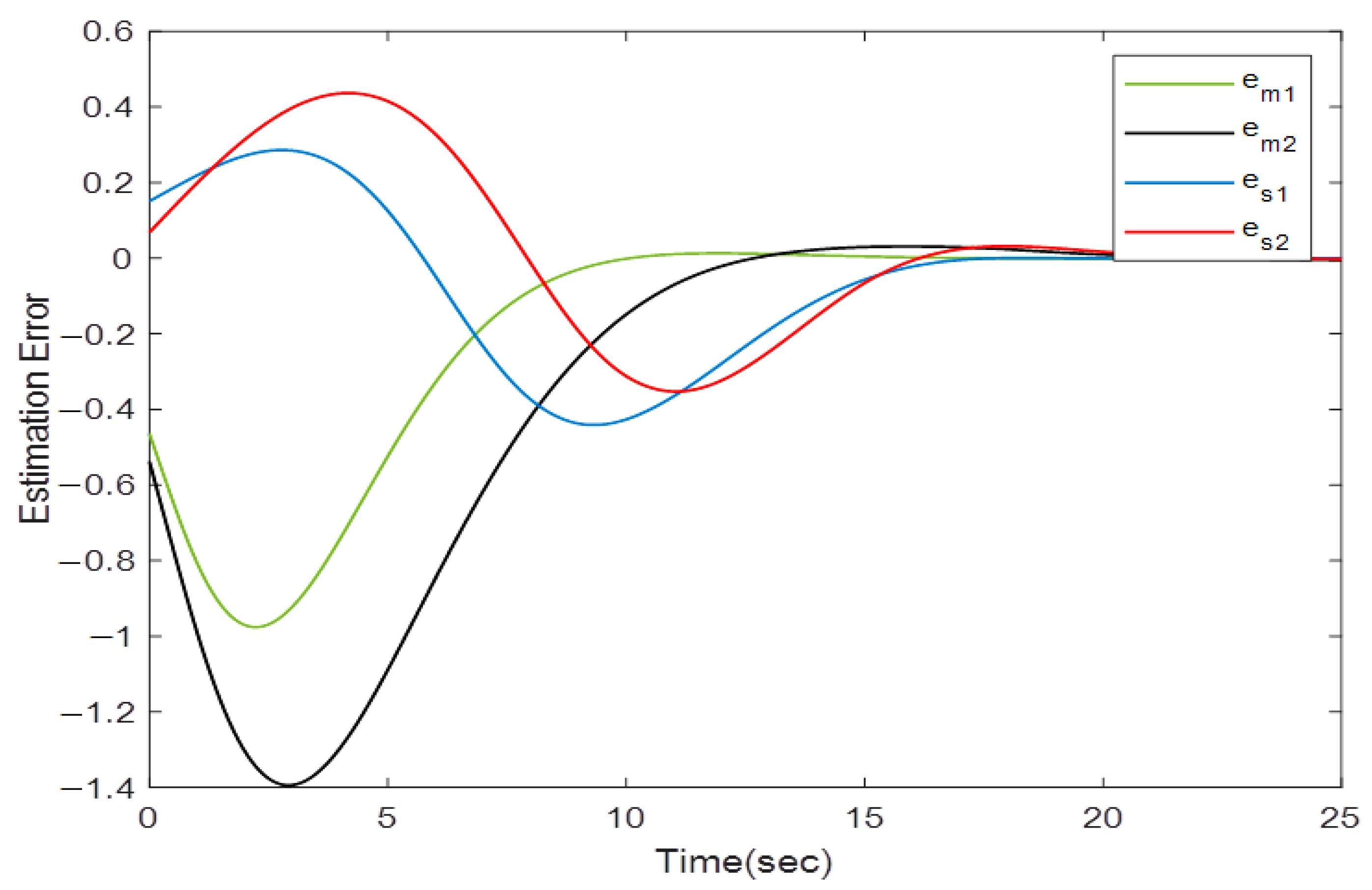1. Introduction
Teleoperation systems have been extensively deployed in remote and hazardous environments during the last decades. A teleoperation system consists of master and slave mechanical parts where the master manipulates the slave via a human operator. A detailed survey of common definitions, applications, and developments of teleoperation systems is provided in [
1,
2].
Time delays mainly caused by data transfer across communication channels are considered, representing one of the most significant challenges in teleoperation systems since even a minor time delay can destabilize the entire teleoperation system. Motivated to solve the instability caused by time delays, a wide range of approaches have been proposed even in the recent literature for a continuous-time model of the bilateral systems. In [
3], a modified wave variable compensation has been utilized to passivate the delayed communication channel. In [
4], a robust controller based on a state observer is implemented on a haptic device and an asymmetric teleoperation system. The results demonstrate better tracking performance for force signals. A modified robust adaptive controller with a novel adaptive torque observer for nonlinear teleoperation systems has been proposed in [
5] to overcome time-varying delays, external disturbances and uncertainties in the system dynamics. This structure is relaxed from acceleration measurement and does not require force sensors. In [
6], the admittance control is applied to study the phase transition between the constraint and unconstraint motions in the teleoperator system with haptic feedback. Its stability proof is provided by hybrid systems theory and Lyapunov–Krasovskii approach. A modified motion prediction method is proposed in [
7], based on a state observer with a cascade architecture. Under an adequate set of assumptions for the existence of uncertainties, the prediction errors remain bounded. These results, properly extended, have been applied to a scaled four-channel scheme under time-varying delays in [
8]. Also, a novel adaptive-observer-based scaled controller for four-channel systems is presented in [
9] to overcome asymmetric time-varying delays.
Besides these model-based methods, data-driven approaches have also been utilized in teleoperation systems. In [
10], an adaptive neural network-based controller is designed in the existence of external disturbances, constant time delay, and internal frictions. Also, in [
11], a truncated quantile critics reinforcement learning-based integrated structure is presented, leading to the quantifiable training feedback in a teleoperation system. A radial basis function neural network (RBFNN) is applied in [
12] to estimate dynamic uncertainties in the existence of the actuator backlash-like hysteresis and time-varying delays.
Obviously, all of the studies above mainly have focused on the continuous-time teleoperation systems, neglecting the handling of some practical parameters such as data-swap, the sampling rate effect, and update rates of actuators on the system’s stability. However, this investigation can be instructive in experimental studies such as [
13], which proposes an open-source scheme of a wearable 7-DOF wireless operator arm motion-tracking system for teleoperator systems or in [
14], where a force tactile feedback approach for finger tracking systems is presented.
Although continuous-time teleoperator systems have received much attention, there are far fewer studies for sampled-data counterparts. However, some discrete-nature controllers have been reported for teleoperation systems in recent years. A review of discrete-time control methods for sampled-data teleoperator systems has been presented in [
15]. Also, a detailed comparison between the behavior of analog and sampled-data teleoperation systems is investigated in [
16]. In [
17], the data transfer from multiple slave robots to the master robot is regulated using the round-robin (RR) scheduling algorithm for a class of sampled-data teleoperation systems. In [
18], an original method to teleoperate a discrete hyper-redundant robots is presented by utilizing mixed reality to carry out complex tasks in remote environments with more accuracy. In [
19], a modified discrete sliding mode controller is proposed via a new reaching law to overcome the chattering phenomena besides disturbance rejection by utilizing an adaptive extended state observer.
A significant deficiency in previous literature on discrete-time teleoperations systems is that all transmitted signals are sampled with the same sampling rate. However, it is not a sensible assumption in the teleoperation systems due to the isolation of the master and slave robots, which may have different hardware restrictions; thus, a multi-rate approach has been proposed in this paper. In the multi-rate architecture, data are collected through numerous sensors with various sampling rates. The necessity of multi-rate sampling is not just due to different phenomena in the system. Sometimes utilizing different methods to sense the same phenomena provides unequal sampling rates in the system. As an instance in our presented study, the position signal of the master robot can be measured by either encoder, potentiometer or even a camera via image processing. Even if we relinquish applying different sensors, variable delays and data drop out in communication channels lead to different data arriving times for the controllers.
Stability analysis of the multi-rate systems and designing sampled-data controllers have received wide attention in recent years [
20,
21,
22,
23]. In an extension to our previous study in [
24], which proposes Krasovskii-based conditions in the form of LMIs (Linear Matrix Inequalities) to stabilize the linear multi-rate teleoperation systems, this study focuses on sensor allocation with analyzing exponential stability. It is presumed that a continuous-time controller stabilizes the teleoperator system. The goal is to assign each position and velocity signals to sensors with different sampling rates and divide the state vector across sensors so that the multi-rate system remains exponentially stable. Different approaches for dividing the state vector across sensors can lead to stable or unstable systems. Thus, Krasovskii-based conditions satisfy exponential stability. Also, these conditions are employed to design observers on both sides of the teleoperator system. This problem will be transformed into a mixed-integer program with LMIs. The results of this paper are useful in designing sensor networks for teleoperation systems.
The remainder of this study is organized as follows. In
Section 2, preliminaries and sampled-data model of the teleoperator system with multi-rate sampling approach are presented. The exponential stability analysis for sensor partitioning and observer design are provided in
Section 3 and
Section 4, whereas in
Section 5, these results are validated by numerical simulations. In
Section 6 and
Section 7, the results are reported and concluding remarks stated.
3. Sensor Allocation with Exponential Stability Analysis
This section provides a basis for sensor partitioning to guarantee the exponential stability of the sampled-data system. According to the previous section, it is assumed that four sensors with various sampling rates are available, thus .
Data-drop out is modelled via switches in
Figure 2.; let nominate sensing blocks by
where
. We define
as a partition of sensors with the following properties:
Each sensor in
is dedicated to sample one of the transmitted signals on both sides of the system. To parameterize the partition matrix, we define
; its rows correspond to the states, as well as the columns to the
sensors, belonging to the set of
. The matrix’s elements are defined in the Boolean set
. When
; it means that the
j-
th state is sampled by
i-
th sensor or, in other words,
; in the case of
, we have
The maximum admissible sampling periods are known and named by
where
To imply this partitioning to the multi-rate controller the diagonal matrices
is considered as:
It is presumed that sensors have a time-driven structure, and ZOHs are event-driven and update themselves immediately after receiving new data.
The following proposed theorem provides LMIs to assign state vectors to each sensor and assures that the stability does not jeopardize.
Theorem 1. Consider the sampled-data dynamic of the teleoperation system in (6) and (13). For positive scalars α and β and positive definite matrices, and, there exists a sensor network parametrized by a matrix that guarantees the exponential stability with a rate greater than , if it satisfies the following LMIs:where Proof. To verify the theorem above, we present an LKF function and show that the LMIs in (16) and (17) satisfy the stability preliminaries. Let us define the Lyapunov function as:
where
We demonstrate that LMIs in Theorem 1 are sufficient conditions for
in the period among two successive sampling rates. The derivative of
and
are straightforward and can be calculated as:
Considering
for an arbitrary vector
can be simplified as:
A similar inequality can be assigned for the derivative of
as follows:
where
and
.
Let define the augmented parameters as:
Thus:
choosing
and
and substituting (23)–(27) in
yields:
Applying Schur complement, by substituting and , the LMIs (16) and (17) implies . Since (30) is affine in , LMIs (16) and (17) are held for any and satisfy the condition for Theorem 1, completing the proof. □
Based on the theorem above, the problem of state assignments for sensors that satisfies the stability can be restated as finding subject to the and LMIs (16) and (17).
4. Observer Design for the Multi-Rate Teleoperator System
In this section, observer design for the multi-rate teleoperator system has been addressed. For the calculated maximum admissible sampling periods, the contribution of this section is providing Krasovskii-based conditions to design linear observers on both sides of the teleoperator system. The estimation error of the observer should converge to the origin exponentially. The extension schematic of the sampled-data system with multi-rate observers has been depicted in
Figure 3.
In this scheme,
is the gain of Luenberger observer.
and,
have been defined in (3) and (4), respectively. The estimation error of the observer is notified by
Thus, the error dynamics can be defined as:
where:
Thus, Theorem 1 can be extended to calculate the observer gain via provided LMIs.
Theorem 2. Givenand, there exists an observer gainwhich the estimation error of the observer is exponentially stable for that if there exist positive definite matricesandand matricesand, with proper dimensions, satisfying the following LMIs:where and, were defined in (19) and (20) and Proof. The proof is straightforward and similar to the proof of Theorem 1. It is enough to replace the Lyapunov function in (21) with the following terms and proceed with the same steps in Theorem 1.
□
The theorem above provides sufficient conditions for exponential convergence of estimation error to the origin for the multi-rate observer. It is assumed that the upper bound of sampling intervals for all sensors is available. The aim is to design observers whose gains are calculated via an optimization process stated in the forms of LMIs. Indeed, we first find subject to and , and then compute the observer gain as .
5. Numerical Simulation
This section illustrates the circumstance of states assignment between sensors for the teleoperator system via numerical simulations. Two DOF robotic manipulators are considered as master and slave subsystems with the following dynamic parameters:
The exerted force is modelled by mass-spring dynamics with
for spring gain and
for the damper gain; this force is depicted in
Figure 4. It is assumed that the slave robot’s end-effecter has touched the environment at
, as well as the controller gains are set to
and
. The tuning process is based on the method proposed in [
25]. In this approach, the integral of the absolute error is considered a cost function for the optimization algorithm to find optimal gain values for the PD controller to achieve the best tracking performance. According to Theorem 1, the sensor partitioning problem that preserves the stability can be transformed into a mixed-integer program with LMIs. This last is in contrast with our previous study, where the maximum admissible sampling periods and refresh rates had been calculated.
Two scenarios are defined to evaluate the sensor partitioning problem. In the first scenario, the master robot position signal for the first state and second state is presumed to be acquired via encoders at sampling periods up to 0.4 s and 0.6 s, and the rate of the velocity states on both sides will be measured by inertial measurement unit is 0.8 s. Thus, with master robot position signals and master-slave robots velocity signals assigned to the sensors, the sensor network matrix
Y is defined as:
where the rows of this matrix indicate position signals for two links. The first column is related to the encoder with a 0.4 s sampling rate and the second column with a 0.6 s sampling rate. We solve the LMIs in Theorem 1 to find which encoder should be utilized to sample the position signals in the slave side such that the stability is preserved. Solving (16) and (17) with the MATLAB toolbox YALMIP [
26] yields:
, and
. This means that the first and second position states of the slave robot should be assigned to the first encoder and the second encoders, respectively, to provide exponential stability. To validate this concept, the position and velocity trajectories are depicted in
Figure 5,
Figure 6,
Figure 7 and
Figure 8.
Figure 5 and
Figure 6 show the instability of the teleoperator system when the second encoder is utilized for the first position state of the slave robot side. In
Figure 7 and
Figure 8, both teleoperator systems’ stability and transparency are obtained considering the proper sensor partitioning on the slave robot side.
The root mean squared error (RMSE) is the square root of the quadratic mean of all errors. The calculated RMSE error related to
Figure 8 is equal to 0.0003416.
To illustrate the efficiency of multi-rate sampling in comparison with the single-rate sampling, the maximum admissible sampling period based on the LMIs in Theorem 1 is calculated with the YALMIP software [
26] and demonstrated in the following
Table 1.
It is deduced that by applying multi-rate samplers, there will be fewer conservative conditions for sampling instants or update rates to guarantee the system’s stability. Specifically, while the maximum admissible sampling period for position sensor to preserve the stability is 150 ms in the single-rate method, multi-rate architecture can increase this upper bound to 352 ms.
The second scenario assumes that the transmitted signals are assigned to sensors with different and nonuniform sampling rates. These sensors can be categorized as a fast-rate sensor with a maximum sampling interval of 0.2 s, a medium-rate sensor with a maximum sampling interval of 0.6 s and a slow-rate sensor with a maximum sampling interval of 1 s. The aim is to assign these sensors to the transmitted signals on both sides, preserving stability. In this scenario, the sensor network matrix should have eight rows for four position and four-velocity signals and three columns for fast, medium and slow rate sensors. Thus, the number of Boolean elements stored in
is 24. Solving LMIs in Theorem 1, the sensor network matrix
Y is defined as:
In the proposed sensor allocation scheme, position signals are sampled with the fast-rate samplers according to their significant roles in stabilizing the system. Position and velocity trajectories for this case are depicted in
Figure 9 and
Figure 10. The bilateral system becomes unstable if slow-rate sensors are used to sample the position signals.
The calculated RMSE is equal to 0.0002855 for position trajectories related to the scenario 2 and 0.000965 for velocity trajectories.
Now, suppose that the first position states of the master and slave robots are measured with an encoder with an unknown sampling period smaller than 0.4 s, and the second position states are measured with an encoder with a maximum permissible sampling period of 0.6 s. Solving the problem defined in Theorem 2 for
lead to the following observer gain:
The position estimation errors for the teleoperator system are depicted in
Figure 11, which confirms that the observer gain in (39) preserves the exponential stability of the estimation error.
6. Discussion
In this paper, the sensor allocation approach is designed for sampled-data bilateral teleoperation systems. Based on Theorem 1 and its proof, this problem is converted into a mixed-integer program with LMIs that, if satisfied, the teleoperation system’s stability will be preserved. The solution is stated as a sensor network matrix, that its rows represent the transmitted states and its columns show the number of sensors with varying sampling rates. The elements of this matrix are defined in the Boolean set , where 1 means that the state is sampled by the related sensor.
In contrast to in-depth studies on continuous-time teleoperation models in the literature, there is less research on sampled-data teleoperation systems. However, as deduced from the results and simulations in
Section 5, sampling has a significant impact on the stability and neglecting it can undermine both transparency and stability of the teleoperator systems. Compared to similar studies that take the sampling analysis into account and provide a sampled-data model for teleoperator systems such as [
19,
27,
28], the novelty of the proposed method relies on designing a sensor allocation basis for the multi-rate structure of bilateral teleoperator systems. This proposed method covers the significant deficiency in previous literature of discrete-time teleoperations systems, where all transmitted signals are sampled with the same sampling rates. Uniform sampling is not sensible for teleoperation systems since, besides the possibility of utilizing various sensors with varying sampling rates on both sides, master and slave robots may have different hardware restrictions regarding the existence distance. Therefore, a multi-rate approach has been presented in this study to collect data through numerous sensors with various sampling rates, as an extension to our previous investigations, where the maximum sampling interval of sensors has been calculated to guarantee the stability of the teleoperator system. Indeed, in [
29], we introduced a stability framework for single-rate uniform and nonuniform sampling intervals for teleoperator systems. Also, in [
22], the transmission rates’ upper bounds were calculated to guarantee the teleoperator system stability. However, the sensor allocation problem among different possible scenarios was an open question covered in the proposed research work. For this purpose, an additional term is added to Lyapunov-Krasovskii function in (21) based on the diagonal matrix
to consider the multi-rate partitioning of sensors. Thus, the stability concept is stated in LMIs, whose solution yields the sensor network matrix. It is concluded that stability can be guaranteed with higher admissible sampling intervals and less determinative conditions. Compared to other LMI schemes, such as input delay in [
24], the LMIs presented in Theorem 1 impose less determinative conditions on the maximum permissible sampling interval regarding the defined Lyapunov-Krasovskii function.
Finally, the contributions of this study can be summarized as follows:
Designing a sensor allocation structure for bilateral teleoperator systems.
Providing exponential stability analysis for the proposed multi-rate sampling approach to collect data through numerous sensors with various sampling rates in teleoperation systems.
Designing linear observers for master and slave robots sides of sampled-data teleoperation systems relied on Krasovskii-based conditions and maximum admissible sampling periods.
These evaluations can aid in the development of guidelines for more transparent and stable teleoperator systems.

